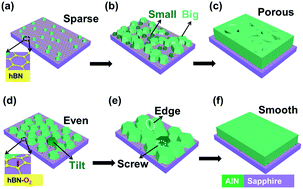Growth mechanism of AlN on hexagonal BN/sapphire substrate by metal–organic chemical vapor deposition†
Abstract
The growth mechanism of AlN materials on a sapphire substrate with a hexagonal BN overlayer (hBN/sapphire) by metal–organic chemical vapor deposition (MOCVD) is reported for the first time. Here, we have grown high-quality AlN films on sapphire with a hBN layer by MOCVD. A growth model has been proposed to clarify the growth mechanism of AlN on hBN. To facilitate the nucleation of AlN on hBN/sapphire, we have introduced some artificial dangling bonds for hBN through O2 plasma treatment (hBN-O2). The change in atom connective structure of hBN materials after the treatment has been inferred according to the results of Raman spectroscopy and X-ray photoelectron spectroscopy. The total dislocation density of AlN on hBN-O2/sapphire is much lower than that of AlN on hBN/sapphire, which has evidenced the high crystalline quality of epitaxial films and the effect of the O2 treatment. Moreover, an AlGaN-based deep-ultraviolet light emitting diode (DUV LED) structure on hBN-O2/sapphire was achieved. The electroluminescence results have exhibited strong emissions with a peak wavelength of 290 nm, which further confirms the high quality of the AlN. This work provides a possible solution for further developing efficient DUV LEDs on 2D materials as well as other unconventional substrates.



 Please wait while we load your content...
Please wait while we load your content...